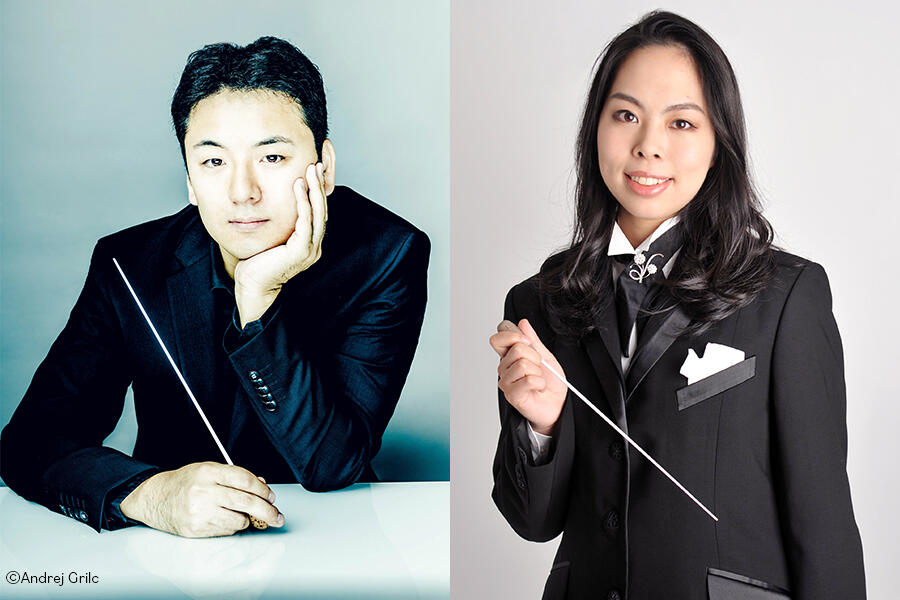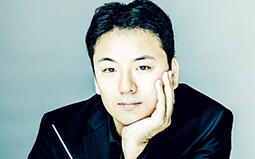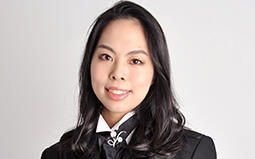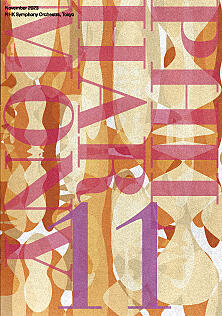- Home
- Concerts
- Subscription Concerts 2023-2024
- Program A
- No. 1997 Subscription (Program A)
No. 1997 Subscription (Program A)
NHK Hall
Google Map Seating Chart

Important Announcement
Program
Sviridov / Small Triptych*
Born two years before the Bolshevik Revolution, Sviridov was a prominent Soviet composer. Originally from the Kursk Province near Ukraine, he learned to play piano and balalaika (traditional stringed instrument with a triangular body) before studying composition under Shostakovich in Leningrad. Small Triptych (1964) is composed of three parts performed continuously. The time of the quasi-mystic first part seems to stand still due to extended melodies altering triple and binary time; besides they are played with “un poco rubato” (a subtle fluctuation of tempo) according to Sviridov’s marking. After the valorous middle part with the brass in the forefront, the finale (in A–B form) opens with piano, celesta and harps evoking the strums of balalaika over which a folky tune is heard.
[Kumiko Nishi]
Prokofiev / War and Peace, opera Op. 91—Waltz in scene 2*
Prokofiev was born in Sontsivka village in Imperial Russia (today in Donetsk Oblast, Ukraine) in the last decade of the 19th century. He led a dramatic life like other Soviet musicians and died in Moscow on the same day as Stalin. Based on Leo Tolstoy's novel, the monumental opera War and Peace was composed from 1941 to 1952 after Prokofiev settled for good in 1936 in his homeland – then the USSR – following an eighteen-year overseas life. The opera tells the love story between the nobles Natasha and Andrei against the backdrop of the 1812 French invasion of Russia. The Waltz is from the famous scene of a New-Year’s-Eve ball where the couple meet for the first time.
[Kumiko Nishi]
Anton Rubinstein / Ballet Music from The Demon, opera —Dance of Girls*
Nowadays, Rubinstein is mentioned above all as a world’s greatest pianist of the 19th century. His prodigious versatility, however, exerted considerable influence more widely on Russian classical music history. He was indeed a prolific composer, a leading conductor and the founder of the Saint Petersburg Conservatory (the country’s first full-fledged music institution) where Tchaikovsky and Prokofiev were trained. Based on Mikhail Lermontov’s narrative poem, The Demon was the Russians’ most favored opera for a quarter century since its 1875 premiere, along with Glinka’s Ivan Sussanin (described below). In the story set in Georgia, the title role (a fallen angel) falls in love with Tamara, mortal and beautiful, just before her marriage to Prince Sinodal. Performed during their wedding festivities, Dance of Girls has a folk atmosphere enhanced by the multiple repetitions of the two melodies.
[Kumiko Nishi]
Glinka / Ivan Sussanin, opera—Krakowiak*
Fascinated by folk melodies of his homeland, Glinka blazed the trail of the distinct Russian style in classical music previous to younger compatriots including Rimsky-Korsakov. Ivan Sussanin, premiered under the title A Life for the Tsar in 1836, is considered the first Russian opera as there had existed only Singspiel-type works (with dialogues spoken) by then. Described “a national heroic-tragic opera” by Glinka, it is based on the 17th-century-legend of a patriotic peasant who sacrificed himself to save the life of Tsar Michael I from Polish troops. The opera gives a vivid contrast between the music embodying Russians and Poles. A Polish folk dance with syncopated rhythms (displacement of accents), Krakowiak is from the scene of a ball held by Polish nobles.
[Kumiko Nishi]
Rimsky-Korsakov / Snow Maiden, suite*
Rimsky-Korsakov’s pursuit of a national style as Glinka’s heir belonged to one of the two mainstreams of the late-19th-century Russian music scene, in opposition to the more Western European style of Tchaikovsky. On an individual level, the composer of Scheherazade is celebrated for his peerlessly masterful orchestration which he fully displays in Snow Maiden (1881). Set in prehistoric age, this fairy-tale opera features the mythical title-role, the daughter of Grandfather Frost and Spring Beauty. The cause of a long-lasting winter, the heroine melts away in the sunlight upon discovering human love so spring comes back at last. The suite prepared by the composer in 1895 includes the opera’s introduction which lets us enjoy one of the most ice-cold-sounding orchestral works ever written.
[Kumiko Nishi]
Tchaikovsky / Fedoseyev / The Sleeping Beauty, ballet suite**
The year 1886 was a crucial one for ballet history, for Ivan Vsevolozhsky, then the director of the Imperial Theatres in Saint Petersburg, took two drastic measures. One was relocating the Imperial Ballet from the aging Bolshoi Kamenny Theatre to the newer Mariinsky Theatre. The other, was putting an end to the post of principal composer at the Imperial Ballet aiming at diversifying ballet music. This would give birth to the two masterworks, The Sleeping Beauty and The Nutcracker (premiered respectively in 1890 and 1892 at the Mariinsky Theatre) of which Vsevolozhsky commissioned Tchaikovsky to compose the scores. More than a decade had passed then, since the composer suffered a bitter experience at the premiere of Swan Lake in Moscow with his music being treated disrespectfully.
The orchestral suite performed today was prepared by the conductor Vladimir Fedoseyev himself, a true champion of Tchaikovsky’s music. Composed of twelve numbers (with some cuts) from The Sleeping Beauty, this version is opened by the noble I March from the ceremonial scene of the baby Princess Aurora’s baptism. The graceful IV Waltz is danced by villagers holding flower garlands for the heroine’s sixteenth birthday party. The suite ends with the famous number known as “Rose” XII Aurora and Désiré’s Adagio: it is danced by Aurora and her four suitors during the birthday party scene, before she falls into a 100-year sleep by pricking her finger on a cursed spindle.
[Kumiko Nishi]
Artists
 ConductorAkito Hiraishi*
ConductorAkito Hiraishi*
 ConductorHiroe Yukawa**
ConductorHiroe Yukawa**
Artists have been changed from initially scheduled Vladimir Fedoseyev (Conductor).
Download
Ticket
Program A
No. 1997 Subscription (Program A)
NHK Hall
Google Map
Seating Chart
Single Tickets Release Date
Pre-sales for Subscribers:Thursday, July 27, 2023
*about subscribers
Sale to General Public:Sunday, July 30, 2023
Price
| S | A | B | C | D | E | |
|---|---|---|---|---|---|---|
| Ordinary Ticket | 9,100 | 7,600 | 5,900 | 4,800 | 3,800 | 2,000 |
| Youth Ticket | 4,000 | 3,500 | 2,800 | 2,100 | 1,500 | 1,000 |
Seating chart Enlarge Print PDF
*tax included
*Subscribers receive a 10% discount (Available at NHKSO WEB Ticket and N-Kyo Guide)
*For wheelchair-accessible seats, please refer to the N-Kyo Guide
Youth Tickets
Youth Tickets are great options for those of 25 years old and younger
Subscription tickets
Release Date
ANNUAL SUBSCRIPTION TICKETS/
SEASONAL SUBSCRIPTION TICKETS (AUTUMN)
Mon., July 17, 2023 10:00am
[For Subscribers: Sun., July 9, 2023 10:00am]
For further information and
subscription application
Other Ticket Agents
Broadcast
 NHK-FMNo. 1997 Subscription (Program A)
NHK-FMNo. 1997 Subscription (Program A)
Thursday, Nov 30, 2023 7:30PM - 9:10PM
Program:
Sviridov / Small Triptych*
Prokofiev / War and Peace, opera Op. 91—Waltz in scene 2*
Anton Rubinstein / Ballet Music from The Demon, opera —Dance of Girls*
Glinka / Ivan Sussanin, opera—Krakowiak*
Rimsky-Korsakov / Snow Maiden, suite*
Tchaikovsky / Fedoseyev / The Sleeping Beauty, ballet suite**
Conductor:Akito Hiraishi*
Conductor:Hiroe Yukawa**
Recorded:November 25, 2023 NHK Hall
*Repertoire, conductor, soloists and program order are subject to change without notice.
*Pre-school children are not allowed in the concert hall


